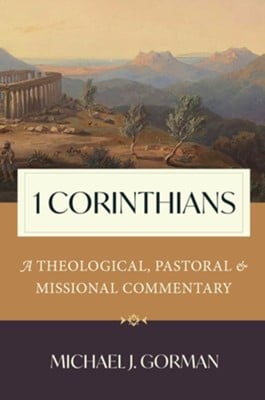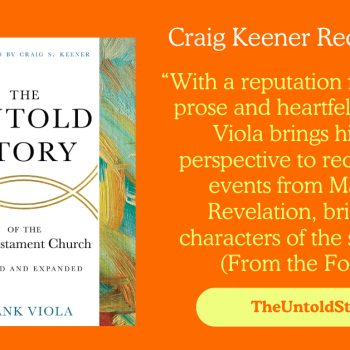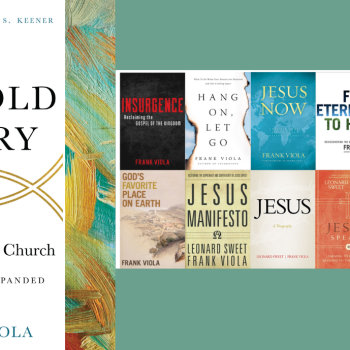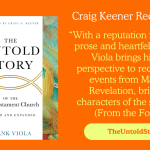In my new book The Untold Story of the New Testament Church: Revised and Expanded, I provide a detailed background within a narrative arc behind each of Paul’s epistles.
1 Corinthians is no exception. Although 1 Corinthians was actually Paul’s second epistle to the church in Corinth. The first one, mentioned in 1 Corinthians 5, is lost to us.
In this connection, Michael Gorman’s 1 Corinthians: A Theological, Pastoral, and Missional Commentary (Eerdmans, 2025) represents a significant contribution to contemporary biblical scholarship that successfully bridges the often-artificial divide between academic rigor and practical application.
Building on the success of his highly regarded Romans commentary, Gorman has crafted a work that serves multiple audiences without compromising its scholarly integrity or pastoral sensitivity.
Methodological Innovation
What distinguishes Gorman’s approach is his explicit integration of three interpretive lenses: theological, pastoral, and missional. Rather than treating these as separate concerns, he demonstrates how they are “inextricably linked” in what he calls “living Christianity.”
This methodology represents a refreshing departure from commentaries that either remain trapped in technical minutiae or sacrifice exegetical depth for popular appeal. Gorman’s theological interpretation operates with what Richard Hays calls “reading with the eyes of faith,” yet maintains critical scholarly standards throughout.
The commentary’s structural innovation is equally noteworthy. Rather than providing exhaustive verse-by-verse analysis, Gorman organizes his treatment around “discourse units,” focusing on larger contextual meanings while avoiding the trap of becoming a “commentary on the commentaries.”
This approach allows readers to see the forest without losing sight of important trees, making the commentary accessible to pastors and educated laypeople while remaining valuable for scholars.
Theological Framework
Gorman’s theological interpretation centers on what he terms the “resurrectional, charismatic, cruciform” life—a framework that captures Paul’s vision of Christian existence shaped by both cross and resurrection, empowered by the Spirit. His concept of “cruciformity” (cross-shaped living) provides a unifying thread that helps readers understand how Paul’s various ethical instructions flow from his Christological convictions.
Gorman frequently uses the word cruciformity in the commentary, describing the Christian life as fundamentally cross-shaped and enabled by the Holy Spirit.
Particularly compelling is Gorman’s use of the traditional four marks of the church—unity, holiness, catholicity, and apostolicity—as an organizing principle for understanding Paul’s concerns in 1 Corinthians.
This ecclesiological framework demonstrates how Paul’s seemingly disparate instructions about factions, sexual ethics, worship practices, and spiritual gifts all serve the larger goal of forming a community that embodies these characteristics.
Pastoral Sensitivity
The commentary excels in its pastoral dimension, with each section concluding with “spiritual, pastoral, missional, and theological reflections” followed by thought-provoking questions for teachers and preachers.
These additions transform the commentary from a purely academic exercise into a practical resource for church ministry. Gorman’s pastoral heart is evident in his handling of difficult texts, such as his nuanced treatment of 1 Corinthians 14:33-35 on women’s silence in worship, where he balances scholarly options with pastoral wisdom.
The three-part introduction structure, while unusual, serves the commentary’s pastoral goals well. By beginning with an overview of Paul’s life and theology, followed by methodological explanation, and concluding with detailed background on 1 Corinthians itself, Gorman ensures that readers have the necessary context to understand both the historical situation and contemporary relevance of Paul’s letter. Paul’s concern is to redefine power in the light of the cross and to keep the resurrected Lord united to the crucified Messiah in a contemporary context.
Strengths and Minor Limitations
The commentary’s greatest strength lies in its synthetic vision—the ability to hold together rigorous exegesis, theological depth, and practical application without sacrificing any component. Gorman’s writing style is engaging and accessible, making complex theological concepts understandable without oversimplification. His frequent references to historical commentators alongside contemporary scholarship demonstrate both breadth of learning and respect for the interpretive tradition.
The limited interaction with modern commentaries, while intentional, may leave some scholarly readers wanting more engagement with current debates. However, this limitation is offset by the commentary’s clear focus and accessibility. The decision to avoid extensive footnotes and technical discussions makes the work more approachable for its intended pastoral audience.
Conclusion
Taken together, Michael Gorman’s 1 Corinthians provides preachers, teachers, and students of the Bible with an excellent resource that successfully demonstrates how serious biblical scholarship can serve the church’s mission.
This commentary will prove invaluable for pastors preparing their talks, teachers leading Bible studies, and anyone seeking to understand how Paul’s ancient letter speaks to contemporary Christian communities. Gorman has produced a work that embodies his own methodological commitment to theological interpretation as both intellectually rigorous and practically transformative—exactly what the church needs in our current moment.














